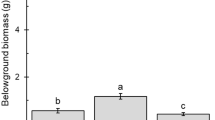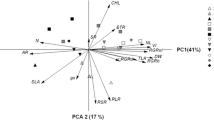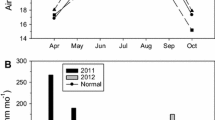Abstract
A study was conducted under greenhouse conditions to examine the effects of various soil moisture regimes on black willow (Salix nigra) posts (cuttings). Five treatments representing a range of soil moisture regines, from continuous flooding to mild drought, were imposed separately. A well-watered, welldrained treatment served as the control. Leaf gas exchange (stomatal conductance and net photosynthesis), survival, and biomass production of posts were evaluated. The stomatal conductance and net photosynthesis data clearly demonstrated the sensitivity of willow posts to low oxygen conditions, (under flooded treatments) as well as to soil drought. Growth and biomass were also adversely affected by flooding and drought treatments. The patterns of root development along the posts seemed to be associated with the watering regime. Root biomass was depressed in zones subjected to flooding and low soil redox potential. In addition, leaf area, leaf biomass, and shoot (leaf+branch) biomass were significantly lower in the continuously-flooded and drought treatments as compared to control plants. Results indicated that maximum photosynthesis and growth in willow posts required ample soil moisture (but non-waterlogging conditions) and adequate drainage in the top 60 cm of soil. The use of willow posts for streambank restoration remains as a viable strategy; however, considerations should be given to water-table elevations, soil Eh conditions, soil moisture regime, and soil texture in order to improve the prospect for successful results.
Similar content being viewed by others
Literature Cited
Abt, S.R., C.C. Watson, J.P. Burgi, D.L. Derrick, and J.H. Batka. 1996. Willow posts construction and evaluation on Harland Creek, Mississippi. p. II14–II23.In Proceedings of the Sixth Federal Interagency Sedimentation Conference, Las Vegas, NY, USA.
Armstrong, W., R. Brandle, and M.B. Jackson,. 1994. Mechanisms of flood tolerance in plants. Acta Botanica Neerlandica 43:307–358.
Dawson, T.E. 1990. Spatial and physiological overlap of three cooccurring alpine willows. Functional Ecology 4:13–25.
Decamps, H. 1996. The renewal of floodplain forests along rivers: a landscape perspective. Vereinigung foer Theoretische und Angewandte Limnologie 26:35–59.
DeLaune, R.D. and S.R. Pezeshki. 1991. Role of soil chemistry in vegetative ecology of wetlands. Advances in Soil Science 1:101–113.
Donovan, L.A., K.W. McLeod, K.C. Sherrod, and N.J. Stumpff. 1988. Response of woody swamp seedlings to flooding and increased water temperatures. I. growth, biomass, and survivorship. American Journal of Botany 75:1181–1190.
Frazee, R.W. and D.P. Roseboom. 1997. Development of willow post stabilization techniques for incised channelized Illinois streams. p. 313–318.In S.S.Y. Wang, E.J. Langendon, and F.D. Shields Jr. (eds.) Proceedings of the Conference on Management of Landscapes Disturbed by Channel Incision, University of Mississippi, Oxford, MS, USA.
Gambrell, R.P., R.D. DeLaune, and W.H. Patrick, Jr. 1991. Redox processes in soils following oxygen depletion. p. 101–117.In M.B. Jackson, D.D. Davies, and H. Lambers (eds.) Plant Life Under Oxygen Deprivation: Ecology, Physiology, and Biochemistry. SPB Academic Publishing bv, The Hague, The Netherlands.
Grissinger, E.H. and A.J. Bowie. 1984. Material and site controls of stream bank vegetation. Transactions American Society of Agricultural Engineers 27:1829–1835.
Hiscox, J.D. and G.F. Israelstam. 1979. A method for the extraction of chlorophyll from leaf tissue without maceration. Canadian Journal of Botany 57:1332–1334.
Jensen, C.R., R.J. Luvmore, S.D. Van Grundey, and L.H. Stolzy. 1969. Root air space measurement by a pycnometer method. Agronomy Journal 61:474–475.
Kozlowski, T.T. 1982. Water supply and tree growth. Part II. Flooding. Forestry Abstracts 43:145–161.
Kozlowski, T.T. 1984. Flooding and Plant Growth. Academic Press, New York, NY, USA.
Kozlowski, T.T., P.J. Kramer, and S.G. Pallardy. 1991. The Physiological Ecology of Woody Plants. Academic Press, San, Diego, CA, USA.
McLeod, K.W., L.A. Donovan, N.J. Stumpff, and K.C. Sherrod. 1986. Biomass, photosynthesis and water-use-efficiency of woody swamp species subjected to flooding and elevated water temperature. Tree Physiology 2:341–346.
Mitsch, W.J. and J.G. Gosselink. 1993. Wetlands, 2nd edition, van Nostrand Reinhold Company, New York, NY, USA.
Patrick, W.H., Jr. and R.D. DeLaune. 1977. Chemical and biological redox systems affecting nutrient availability in the coastal wetlands. Geoscience and Man XVIII:131–137.
Pezeshki, S.R. 1991. Root responses of flood-tolerant and floodsensitive tree species to soil redox conditions. Trees Structure and Function 5:180–186.
Pezeshki, S.R. 1994. Plant responses to flooding. p. 289–321.In R.E. Wilkinson (ed.) Plant Environment Interactions. Marcel Dekker, Inc., New York, NY, USA.
Pezeshki, S.R. and P.H. Anderson. 1997. Response of three bottomland species with different flood-tolerance capabilities to various flooding regimes. Wetland Ecology and Management 4:245–256.
Pingry J.W., S.T. Gower, and G.D. Bubenzer. 1997. Streambank stabilization: A case study on the West Fork Kickapoo River in Wisconsin. p. 313–318.In S.S.Y. Wang, E.J. Langendon, and F.D. Jr. (eds.) Proceedings of the Conference on Management of Landscapes Disturbed by Channel Incision, University of Mississippi. Oxford, MS, USA.
SAS. 1990. Procedures Guide, version 6. 3rd Edition, p. 705, SAS Institute Inc., Cary, NC, USA.
Shields, F.D. Jr., S.S. Knight, and C.M. Cooper. 1995a. Streambank protection and habitat restoration. p. 721–725.In Proceedings of 1st International Conference, Water Resources Engineering Division, American Society of Civil Engineers, San Antonio, TX, USA.
Shields, F.D. Jr., C.M. Cooper, and S.S. Knight. 1995b. Experiments in stream restoration. Journal of Hydraulic Engineering 121:494–502.
Shields, F.D. Jr., S.R. Pezeshki, and P.H. Anderson. 1998. Probable causes for willow post mortality.In Proceedings of American Society of Civil Engineers, Denver, CO, USA.
Talbot, R.J., J.R. Etherington, and J.A. Bryant. 1987. Comparative studies of plant growth and distribution in relation to waterlogging. XII. Growth, photosynthetic capacity and metal ion uptake inSalix caprea andS. cinerea spp.opeifolia. New Phytologist 105:563–574.
Watson, C.C., D. Gessler, and S.R. Abt. 1995. Inspection of Selected Bank Stabilization Sites. Inernal report: U.S. Army Corps of Engineers, Vicksburg, MS, USA.
Wolfe, J.A. 1992. Field plantings of four willow selections (1984–1989). Project Report No. 6 for the Jamie L. Whiten Plant Material Center, Coffeeville, MS, USA.
Yamasaki, T. 1952. Studies on the “excess-moisture injury” of upland crops in overmoist soil from the view point of soil chemistry and plant physiology. Bulletin of National Institute of Agricultural Sciences (Japan) B1:1–92.
Author information
Authors and Affiliations
Rights and permissions
About this article
Cite this article
Pezeshki, S.R., Anderson, P.H. & Shields, F.D. Effects of soil moisture regimes on growth and survival of black willow (Salix nigra) posts (cuttings). Wetlands 18, 460–470 (1998). https://doi.org/10.1007/BF03161538
Received:
Revised:
Accepted:
Issue Date:
DOI: https://doi.org/10.1007/BF03161538




